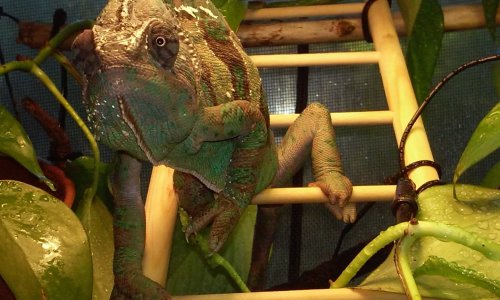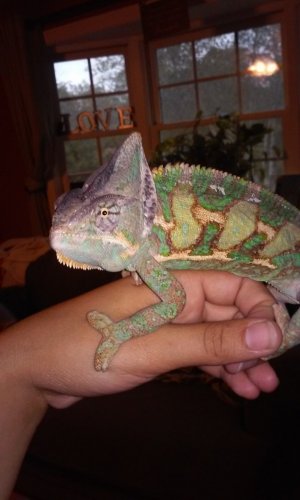Erica1884
Avid Member
Chameleon Info:
Cage Info:
Current Problem - The current problem you are concerned about. Curious as to whether or not it is normal for my boy to have such dull colors when he is in his cage.... but when he comes out he has very pretty bright colors, I am on a face book page for cham fans and people are always commenting on others photos saying that the dull color of the cham in the enclosure means something is wrong... I did not think that was true... Any thoughts? I will post two picks as a comment one in his cage and one out. Thanks in advance
- Your Chameleon - The species, sex, and age of your chameleon. How long has it been in your care? Male veiled, 14 months old, had him for 7-8 months
- Handling - How often do you handle your chameleon? at least once a day, very social
- Feeding - What are you feeding your cham? What amount? What is the schedule? How are you gut-loading your feeders? crickets (8-10) every day or every other day. Morning feedings, Mazuri gut loading feed, orange flukers cubes, grapes, carrots
- Supplements - What brand and type of calcium and vitamin products are you dusting your feeders with and what is the schedule? zoo med calcium every feeding, zoomed calcium plus d3 twice a month, exoterra multi vitamin twice a month
- Watering - What kind of watering technique do you use? How often and how long to you mist? Do you see your chameleon drinking? Drip system, three to four times daily, yes mainly when I spray
- Fecal Description - Briefly note colors and consistency from recent droppings. Has this chameleon ever been tested for parasites? Brown, well formed, white urinate. No
- History - Any previous information about your cham that might be useful to others when trying to help you. Just lost two toe nails due to screen cage, has been rescreened since. Toes seem fine. I can see the nails on both, flush with his skin, dark colored nails, no swelling, climbing fine
Cage Info:
- Cage Type - Describe your cage (Glass, Screen, Combo?) What are the dimensions? Screened 24x24x48
- Lighting - What brand, model, and types of lighting are you using? What is your daily lighting schedule? 75 watt basking, 100 watt uvb, 60 watt night light, blue Day light 630am, night light 630 pm
- Temperature - What temp range have you created (cage floor to basking spot)? Lowest overnight temp? How do you measure these temps? Basking is 85-95. lowest spot 65-70. probe and dial gauge temps
- Humidity - What are your humidity levels? How are you creating and maintaining these levels? What do you use to measure humidity?60-80 probe and dial gauges. Spraying
- Plants - Are you using live plants? If so, what kind? one schaferal (spelling..) and two pothos
- Placement - Where is your cage located? Is it near any fans, air vents, or high traffic areas? At what height is the top of the cage relative to your room floor? He is in his own room, by a window top of the cages is about 5'6 or 5'7
- Location - Where are you geographically located? Plymouth, Ma
Current Problem - The current problem you are concerned about. Curious as to whether or not it is normal for my boy to have such dull colors when he is in his cage.... but when he comes out he has very pretty bright colors, I am on a face book page for cham fans and people are always commenting on others photos saying that the dull color of the cham in the enclosure means something is wrong... I did not think that was true... Any thoughts? I will post two picks as a comment one in his cage and one out. Thanks in advance



